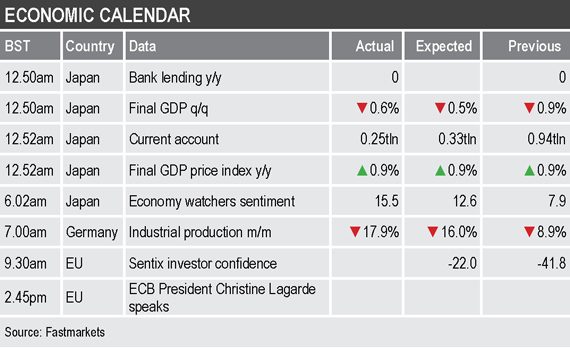Asian-Pacific equities, although stronger this morning, were not up by the same extent as western equity indices were on Friday.
- China’s exports rose by just 1.4% year on year in May after rising by 8.2% in April. Imports fell by 13% in May…
- …but imports of copper climbed by 20.8% year on year, though were still down by 5.5% from April.
Base metals
Three-month base metals prices on the London Metal Exchange were mixed this morning; copper, lead and zinc were down between $2-8 per tonne, with copper off $2 at $5,657.50 per tonne, while aluminium, nickel and tin were up by between 0.2% and 0.8%, with tin leading on the upside and recently quoted at $16,525 per tonne.
All the metals extended their rebound gains last week with prices now on average some 11% below their mid-January, pre-Covid-19 crisis highs compared with an average drop at of 26% at the low point of the sell-off.
The most-traded base metals contracts on the Shanghai Futures Exchange were also mixed, with July lead and zinc showing losses of 0.2% and 1.2% respectively, while the rest were up between 0.6% for August nickel and 2% for August tin, with July copper up by 1.5% at 45,690 yuan ($6,451) per tonne.
Precious metals
Spot gold prices were firmer this morning, up by 0.4% at $1,690.45 per oz, this after a low of $1,670.30 per oz on Friday. The rest of the precious metals were showing gains of between 1.4% and 2%. Gold and silver prices have been trending lower in recent days, while the platinum group metals have been holding up relatively well.
Wider markets
The yield on benchmark US 10-year treasuries continues to climb and was recently quoted at 0.9%, this after 0.83% at a similar time on Friday morning. The rise in the yield supports the more risk-on climate and helps explain the strength in equities of late. The stronger yield has started to provide some support to the dollar.
Asian-Pacific equities were higher this morning: the Nikkei (+1.38%), the ASX 200 (closed), the Hang Seng (+0.01%), China’s CSI 300 (+0.56%) and the Kospi (+0.11%), but interestingly they have not climbed to the extent western indices did on Friday, when the Dow Jones Industrial Average and EuroStoxx 50 closed up by 3.15% and 3.76% respectively.
Currencies
The US dollar index is consolidating recent weakness and was recently quoted at 96.87, this after a low of 96.44 on Friday.
While the dollar finds some support, most of the other major currencies we follow have also started to consolidate recent strength: the euro (1.1295), the Australian dollar (0.6974) and sterling (1.2693), although the yen (109.45) is consolidating after weakening in recent weeks.
The Chinese yuan (7.0773) is strengthening, it was at 7.0923 at a similar time on Friday and is recovering from recent weakness – it set a low at 7.1770 in late-May. The stronger yuan suggests some easing in United States-China tension, but whether that lasts now China’s trade surplus has widened again remains to be seen.
Key data
Monday’s economic data shows Japan’s final gross domestic product declined by 0.6% quarter on quarter in the first three months of the year – earlier readings had suggested a 0.9% drop – and the country’s index on economic sentiment climbed to 15.5 for May from 7.9 in April. Germany’s industrial production data for April showed a 17.9% month-on-month fall, after an 8.9% fall in March.
Later there is data on European Union investor confidence from Sentix and European Central Bank President Christine Lagarde is speaking.
Today’s key themes and views
The rebounds in the base metals prices are for the most part looking strong and much of that is put down to high hopes for better demand from infrastructure projects, although if that is the case it is interesting that zinc is still down the most from pre-crisis levels with prices down 16%, compared with the rest being down by an average of 11%.
Overall, we expect the promised spending on infrastructure to boost demand for the metals and we fear there is increased risk that there will be more supply disruptions in the months ahead while economies ease Covid-19 restrictions before they have the virus under control.
Gold prices have rolled over to the downside for now because the run-up in equities and bond yields are increasing the opportunity cost of holding gold. But given that the rebound in equities may have run ahead of itself and there is still a lot of uncertainty as to how we recover from this pandemic, it seems likely that investors will want to continue to hold higher levels of gold in their portfolios. As such, we expect dips will be well supported.



